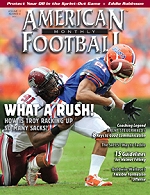Article CategoriesAFM Magazine
|
Adjust Your Defensive Backs – Coaching pattern-read coverage vs. trips and single-width formations.by: Jared WiggerDefensive Coordinator • Labette County High School (KS) © More from this issue Pattern-read coverage continues to be a sound defensive scheme that is employed on all levels due to its ability to aggressively attack routes and disrupt the timing of an offense. One of the first principles we teach when installing our cover 4 is “don’t cover grass”. We want our players to understand that even though our coverage begins with a zone concept, at some point in the progression of the play, everyone should be matching a route based on each receiver’s release. One area that has traditionally challenged pattern-read coverages are 3 x 1 and single width sets. We began double calling our coverages a number of years ago to handle this, which led to the necessity of coaching pattern-read within a cover 3 type of scheme. As we began teaching this scheme, we developed a system of keys and coa....The full article can only be seen by subscribers.
|
|
|||||||
| HOME |
MAGAZINE |
SUBSCRIBE | ONLINE COLUMNISTS | COACHING VIDEOS |
Copyright 2026, AmericanFootballMonthly.com
All Rights Reserved





